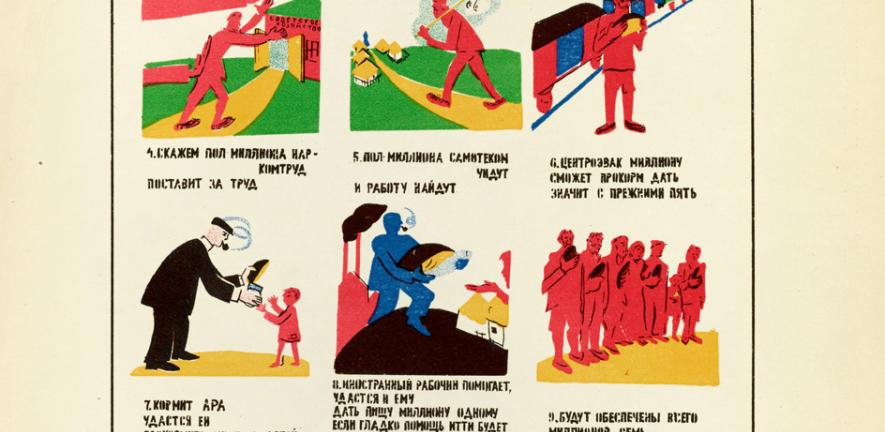
A unique tour through the Soviet century – via one woman’s extraordinary collection of books, propaganda posters, ration coupons and even cigarette packets – is the focus of a new exhibition opening to the public on July 4.
A unique tour through the Soviet century – via one woman’s extraordinary collection of books, propaganda posters, ration coupons and even cigarette packets – is the focus of a new exhibition opening to the public on July 4.
The turmoil of the Soviet century, good and bad, will reach anyone through the visual force of Catherine’s astonishing collection.
Mel Bach
Dr Catherine Cooke, a world-renowned expert on Soviet architecture and design, spent decades amassing a vast and eclectic collection of thousands of books, journals, postcards and other ephemera before her tragic death at the height of her intellectual powers in 2004, aged 61.
A Soviet Design for Life: The Catherine Cooke Collection of 20th Century Russian Architecture and Design is on display at Cambridge University Library’s Exhibition Centre from July 4, 2012 to April 6, 2013 (admission free).
Containing rare and unusual items, many on display for the first time, A Soviet Design for Life chronicles life in Russia from the late Tsarist period to perestroika through the prism of art, architecture and design.
As well as propaganda posters and rare books, Catherine Cooke also collected everyday and seemingly mundane items, including bank notes, badges, perfume bottles, professional membership cards and even food packaging – anything that caught her eye from a design perspective.
Mel Bach, who has curated the University Library exhibition, said: “Soviet design and architecture are of increasing interest, as witnessed by the Royal Academy’s recent show ‘Building the Revolution’. Our exhibition breaks new ground not only because it’s based on this major figure’s own, rather visionary collection, but also because it looks at Soviet design in the everyday as well as the monumental.
“In our exhibition, envelopes and cigarette packets take their place alongside plans for some of the most iconic buildings of the 20th century. The exhibition provides a narrative about the Soviet period from an unusual angle, looking at its themes through examples of design. For example, we see political education through the beautiful illustration of a children’s book.
“We can see the books that academics wrote and the plans that architects drew, but also ration coupons which Leningrad inhabitants used after the Second World War, the badges which later Soviets wore to celebrate the Moscow Olympics in 1980, the cigarettes that were smoked, the postcards that were sent. The exhibition features major historical moments but also reminds us of the ordinary people and the day-to-day stories of their lives.”
Using Catherine’s extraordinary collection to illustrate many of the design principles underpinning Soviet thinking through Lenin, Stalin and beyond, the exhibition examines key Communist themes and ideals such as education, work and faith (in the new regime) – all of which were consistently transmitted to the population through subtle and not so subtle methods of dissemination.
A Cambridge graduate, Catherine returned to the university and gained a PhD in 1975 for her thesis on ‘The Town of Socialism: the origins and development of Soviet town planning’.
In the 1980s, when Modernist Soviet buildings – particularly those in Moscow – were in danger of being demolished, she began to record and list them, eventually joining Docomomo, an international organisation concerned with the preservation of Modernist architecture.
Following glasnost and the thawing of the Cold War, Catherine was able to travel much more freely throughout Russia. Accompanying her on trips was a fold-up bike she used to cycle around various provincial towns photographing architecture and creating bewilderment among the local populace, and sometimes suspicion among the local authorities.
Added Bach: “Catherine collected a great variety of surprising and rare things. For example, she owned the original of a letter sent to American artists by 32 of their counterpart Russian artists, designers, and architects during the very early years of the Soviet period. Signed by luminaries such as Rodchenko, Malevich, and Tatlin, the letter is an extraordinary primary source. Another rarity is a 3D book published in 1934 which is made up of posters of instructions for the maintenance and use of artillery.
“While the exhibition is about displaying design, the exhibits do tell much of the story of the Soviet Union. We see the earliest days of the Soviet period in propaganda relating to health, education, and politics; we see optimism in the dark days of World War II in postcards, and its long shadow in post-war ration coupons; we see the culmination of the Stalinist period in plans for vast buildings, many of which soar above Moscow to this day; and we see hopes for the future in material showing pride in the space race and the Moscow Olympics.
“The turmoil of the Soviet century, good and bad, will, I hope, reach anyone through the visual force of Catherine’s astonishing collection.”
This work is licensed under a Creative Commons Licence. If you use this content on your site please link back to this page.





